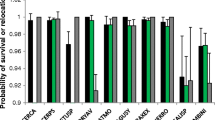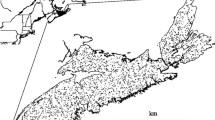Abstract
Tree mortality is an important component of forest tree and stand growth models, which provide decision support for forest managers. Mortality patterns, however, are highly variable and difficult to describe. Despite numerous investigations aimed at developing tree survival models, there are still important gaps that need to be filled. This paper used a large-scale repeated measure dataset collected from permanent sample plots established in 1980/81 across the natural range of loblolly pine (Pinus taeda L.) in the Piedmont, Atlantic Coastal Plain and Gulf Coastal Plain physiographic regions of the US. The primary objective of this study was to explain the survival of loblolly pine trees using time-varying covariates such as diameter at breast height, total tree height, crown ratio, stand age, stand basal area, and dominant height. In this paper, individual-tree mortality was described using a semiparametric proportional hazards regression model. Shared frailty models were used to account for unobserved heterogeneity not explained by the observed covariates. Our investigation involved developing a modeling comparison procedure, predicting mortality based on a frailty model, and quantifying the predictive ability for tree mortality. The survival model developed using a large scale database provides further understanding of mortality trends in planted stands of loblolly pine. The survival model will enable forest managers to more accurately specify initial planting density, thinning schedules, and other management interventions.





Similar content being viewed by others
References
Affleck, D. L. R. (2006), “Poisson mixture models for regression analysis of stand-level mortality,” Canadian Journal of Forest Research, 36(11), 2994–3006.
Antón-Fernández, C. (2008), Towards greater accuracy in individual-tree mortality regression, PhD thesis, Michigan Technological University.
Avila, O. B., and Burkhart, H. E. (1992), “Modeling survival of loblolly pine trees in thinned and unthinned plantations,” Canadian Journal of Forest Research, 22(12), 1878–1882.
Buchman, R. G. (1979), “Mortality functions,” in A generalized forest growth projection system applied to the Lake States region, number NC-49 USDA Forest Service, pp. 47–55.
Burgman, M. A., Incoll, W., Ades, P. K., Ferguson, I., Fletcher, T. D., and Wohlers, A. (1994), “Mortality models for mountain and alpine ash,” Forest Ecology and Management, 67(1-3), 319–327.
Burkhart, H. E., and Tomé, M. (2012), Modeling forest trees and stands, Dordrecht, Netherlands: Springer.
Crowther, M. J., Abrams, K. R., and Lambert, P. C. (2013), “Joint modeling of longitudinal and survival data,” Stata Journal, 13(1), 165–184.
Diéguez-Aranda, U., Castedo-Dorado, F., Álvarez-González, J. G., and Rodŕiguez-Soalleiro, R. (2005), “Modelling mortality of Scots pine (Pinus sylvestris L.) plantations in the northwest of Spain,” European Journal of Forest Research, 124(2), 143–153.
Dobbertin, M., and Brang, P. (2001), “Crown defoliation improves tree mortality models,” Forest Ecology and Management, 141(3), 271–284.
Duchateau, L., and Janssen, P. (2008), The frailty model, New York: Springer.
Eid, T., and Øyen, B. H. (2003), “Models for prediction of mortality in even-aged forest,” Scandinavian Journal of Forest Research, 18(1), 64–77.
Fox, T. R., Allen, H. L., Albaugh, T. J., Rubilar, R., and Carlson, C. (2007), “Tree nutrition and forest fertilization of pine plantations in the southern United States,” Southern Journal of Applied Forestry, 31(1), 5–11.
Guo, X., and Carlin, B. P. (2004), “Separate and joint modeling of longitudinal and event time data using standard computer packages,” The American Statistician, 58(1), 16–24.
Hamilton, D. A. (1974), Event probabilities estimated by regression, Research Paper INT-152, USDA Forest Service, Intermountain Forest and Range Experiment Station, Ogden, Utah.
Hamilton, Jr., D. A. (1986), “A logistic model of mortality in thinned and unthinned mixed conifer stands of Northern Idaho,” Forest Science, 32(4), 989–1000.
Harrell, Jr., F. E. (2001), Regression modeling strategies: with applications to linear models, logistic regression, and survival analysis, New York: Springer-Verlag.
Henderson, R., Diggle, P., and Dobson, A. (2000), “Joint modelling of longitudinal measurements and event time data,” Biostatistics, 1(4), 465–480.
Jokela, E. J., Martin, T. A., and Vogel, J. G. (2010), “Twenty-five years of intensive forest management with southern pines: important lessons learned,” Journal of Forestry, 108(7), 338–347.
Kaplan, E. L., and Meier, P. (1958), “Nonparametric estimation from incomplete observations,” Journal of the American Statistical Association, 53(282), 457–481.
Klein, J. P., and Moeschberger, M. L. (2003), Survival analysis: techniques for censored and truncated data, New York, NY: Springer-Verlag.
Leffondŕe, K., Abrahamowicz, M., and Siemiatycki, J. (2003), “Evaluation of Cox’s model and logistic regression for matched case-control data with time-dependent covariates: a simulation study,” Statistics in Medicine, 22(24), 3781–3794.
Li, J., Hong, Y., Thapa, R., and Burkhart, H. E. (2015), “Survival analysis of loblolly pine trees with spatially correlated random effects,” Journal of the American Statistical Association, 110(510), 486–502.
Li, L., Hu, B., and Greene, T. (2009), “A semiparametric joint model for longitudinal and survival data with application to hemodialysis study,” Biometrics, 65(3), 737–745.
Magnussen, S., Alfaro, R. I., and Boudewyn, P. (2005), “Survival-time analysis of white spruce during spruce budworm defoliation,” Silva Fennica, 39(2), 177–189.
Metcalf, C. J. E., Clark, J. S., and McMahon, S. M. (2009), “Overcoming data sparseness and parametric constraints in modeling of tree mortality: a new non-parametric Bayesian model,” Canadian Journal of Forest Research, 39(9), 1677–1687.
Monserud, R. A. (1976), “Simulation of forest tree mortality,” Forest Science, 22(4), 438–444.
Nelson, W. (1972), “Theory and applications of hazard plotting for censored failure data,” Technometrics, 14(4), 945–965.
Nothdurft, A. (2013), “Spatio-temporal prediction of tree mortality based on long-term sample plots, climate change scenarios and parametric frailty modeling,” Forest Ecology and Management, 291, 43–54.
Rose, E. C., Clutter, M. L., Shiver, B. D., Hall, D. B., and Borders, B. (2004), “A generalized methodology for developing whole-stand survival models,” Forest Science, 50(5), 686–695.
——– (2006), “A multilevel approach to individual tree survival prediction,” Forest Science, 52(1), 31–43.
Schultz, R. P. (1997), Loblolly pine: the ecology and culture of loblolly pine (Pinus taeda L.), Vol. Agricultural Handbook 713, Washington, D.C.: USDA Forest Service.
Therneau, T. M., and Grambsch, P. M. (2000), Modeling survival data: extending the Cox model. New York: Springer-Verlag.
Tsiatis, A. A., and Davidian, M. (2004), “Joint modeling of longitudinal and time-to-event data: an overview,” Statistica Sinica, 14(3), 809–834.
Uzoh, F. C., and Mori, S. R. (2012), “Applying survival analysis to managed even-aged stands of ponderosa pine for assessment of tree mortality in the western United States,” Forest Ecology and Management, 285, 101 – 122.
Vanclay, J. K. (1995), “Growth models for tropical forests: a synthesis of models and methods,” Forest Science, 41(1), 7–42.
Vaupel, J. W., Manton, K. G., and Stallard, E. (1979), “The impact of heterogeneity on individual frailty on the dynamic of mortality,” Demography, 16(3), 439–454.
Volney, W. J. A. (1998), “Ten-year tree mortality following a jack pine budworm outbreak in Saskatchewan,” Canadian Journal of Forest Research, 28(12), 1784–1793.
Wienke, A. (2010), Frailty models in survival analysis, Chapman and Hall/CRC.
Woodall, C. W., Grambschb, P. L., and Thomas, W. (2005), “Applying survival analysis to a large-scale forest inventory for assessment of tree mortality in Minnesota,” Ecological Modelling, 189(1-2), 199–208.
Woollons, R. C. (1998), “Even-aged stand mortality estimation through a two-step regression process,” Forest Ecology and Management, 105(1), 189–195.
Wyckoff, P. H., and Clark, J. S. (2000), “Predicting tree mortality from diameter growth: a comparison of maximum likelihood and Bayesian approaches,” Canadian Journal of Forest Research, 30(1), 156–167.
Yao, X., Titus, S. J., and MacDonald, S. E. (2001), “A generalized logistic model of individual tree mortality for aspen, white spruce, and lodgepole pine in Alberta mixedwood forests,” Canadian Journal of Forest Research, 31(2), 283–291.
Zhao, D., Borders, B., Wang, M., and Kane, M. (2007), “Modeling mortality of second-rotation loblolly pine plantations in the Piedmont/Upper Coastal Plain and Lower Coastal Plain of the southern United States,” Forest Ecology and Management, 252(1-3), 132–143.
Acknowledgments
Funding for this research was made available through the Forest Modeling Research Cooperative (FMRC) at Virginia Tech, the Virginia Agricultural Experiment Station, and the McIntire-Stennis program of the National Institute of Food and Agriculture, USDA, the National Science Foundation Center for Advanced Forestry Systems, and the Pine Integrated Network: Education, Mitigation, and Adaptation Project (PINEMAP), a Coordinated Agricultural Project funded by the USDA National Institute of Food and Agriculture (Award 2011-68002-30185). The authors would like to acknowledge Advanced Research Computing at Virginia Tech for providing computational resources. The authors would also like to thank the editor, an associate editor, and referees, for their valuable comments that helped in improving this paper significantly.
Author information
Authors and Affiliations
Corresponding author
Rights and permissions
About this article
Cite this article
Thapa, R., Burkhart, H.E., Li, J. et al. Modeling Clustered Survival Times of Loblolly Pine with Time-dependent Covariates and Shared Frailties. JABES 21, 92–110 (2016). https://doi.org/10.1007/s13253-015-0217-2
Received:
Accepted:
Published:
Issue Date:
DOI: https://doi.org/10.1007/s13253-015-0217-2




